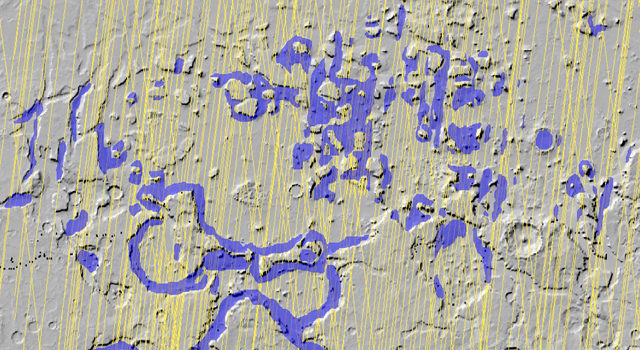[/caption]
Sure, it’s big news the Moon has water ice on the north pole, but Mars is loaded! A new extensive radar mapping of the middle-latitude region of northern Mars shows that thick masses of buried ice are quite common beneath the surface. The Mars Reconnaissance Orbiter’s Shallow Radar instrument has detected subsurface ice deposits that extend for hundreds of kilometers in the rugged region called Deuteronilus Mensae, about halfway from the equator to the Martian north pole. “We have mapped the whole area with a high density of coverage,” said Jeffrey Plaut from JPL. “These are not isolated features. In this area, the radar is detecting thick subsurface ice in many locations.”
The Shallow Radar instrument has been charting the locations of these hidden glaciers and ice-filled valleys, finding that the most common locations are around the bases of mesas and scarps, and confined within valleys or craters. After obtaining more than 250 observations of the study area, which is about the size of California, the science team is beginning to understand how these deposits may have been left as remnants when regional ice sheets retreated.
“The hypothesis is the whole area was covered with an ice sheet during a different climate period, and when the climate dried out,” Plaut said, “these deposits remained only where they had been covered by a layer of debris protecting the ice from the atmosphere.”
These buried masses of ice are a significant fraction of the known non-polar ice on Mars. The ice could contain a record of environmental conditions at the time of its deposition and flow, making the ice masses an intriguing possible target for a future mission with digging capability.
MRO will continue mapping the area to provide more insight into the buried ice.
Source: JPL


I was just wondering yesterday what sort of data the shallow radar was taking. We hear so much about HiRise (justifiably so), that it seems the other instruments seem to get drowned out a bit. Good to see that they are coming up with the goods in spades too…
I say that the new direction for robotic explorers be limited to survival in and probing of ice on other planets/moons.
Why is it that there seems to be little re-use or improvement upon older successful designs? After 50+ years in space, I would imagine some sort of basic model line to be established, which could be modified to suit any particular mission duties with modules.
It would be nice to have a suite of capabilities to choose from on an interchangeable level somewhat like current military aircraft I.E. FA-18.
Imagine this: An orbiter settles into it’s orbit around Mars, deploys a quantity of heated ice probes to the surface which then report back with information about the ice. Next the orbiter deploys a controllable rover to the most promising of the probe locations to do in depth testing.
I knew it!!!! I just knew there was lots of ice under the surface, considering all the sandstorms Mars gets.
This is great news! It opens up the doors for colonization!!! Now all we need is a government that cars about it’s space program! 😉
“thick masses of buried ice are quite common beneath the surface”
How thick? How deep?
What’s the picture scale?
This is huge. You probably won’t see big coverage of it in major news media, but the magnitude of this find could be one of the biggest expeditionary discoveries of our lifetimes.
Because generally we don’t know how to do the old stuff. I know how to make a transistor, I have made more than I care to count, but as for vacuum tubes I have only a general idea.
Electronics may live for more than one generation space craft, if you are lucky. Then you need to pick new components.
I believe it is much the same with experiments. Old Langmuir probes for plasma research et cetera used to have large “pickups”. I hear you don’t see those anymore, they have shrunken an order of magnitude or so for whatever reason.
These might be good places to look for Martian life. This subterranean ice might have some liquid form, maybe transiently under certain conditions of temperature and pressure, which Martian life might be adapted to exploit.
LC
@Manu – Image scale Deuteronilus Mensae “…which is about the size of California.”
Ice sailing anyone? The area near Lyot Crater is where possible ‘ice burgs’ have been I.D.’d as seen in these links: http://www.nasaimages.org/luna/servlet/detail/nasaNAS~4~4~12989~115190:Lyot-Crater-in-Winter
and
http://images.spaceref.com/news/2003/2003.12.04.R1001555.gif
I read where there is a good possibility that moon water will have Mercury in it. I wonder what will the water/ice on Mars will have dissolved in it? Maybe perchlorates?
Manu…
Excellent questions… since the answers provide so much more information than most people realize.
There may be timeline question to answer… since a couple of craters hold water, yet many do not. Could also tell us if it truly was an ice sheet which covered the area.
There are a couple of areas which this reveals, which make me wonder if they were once very old craters, yet were covered up by some changes in the land over time.
Aqua… that would be very kewl if perchlorates were discovered. Can’t help but wonder how its discovery would shift the priorities of NASA’s future missions.
There are ways to rid perchlorates from drinking water, including: 1) anaerobic biodegradation, 2) Reverse-Osmosis (RO), 3) removal with Granular Activated Charcoal (GAC) and 4) Ion Exchange (IX)
Now which of these processes would allow for the easy collection of concentrated perchlorate(s)? What percentage of that concentrated perchlorate can be used for the manufacture of solid rocket fuel? Would it be better to use purified and electrolyzed Hydrogen and Oxygen for fuel? too the perchlorates?
… ahem… “toss the perchlorates?”